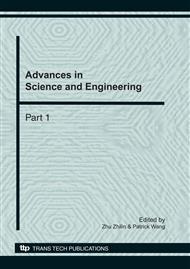[1]
Wang H Y, Lu S: Nonlinear time series analysis and its application. Science press, Beijing (2006).
Google Scholar
[2]
Pompe B: Measuring statistical dependences in a time series. J. Journal of Statistical Physics, 73(3/4), pp.587-610(1993).
DOI: 10.1007/bf01054341
Google Scholar
[3]
Pompe B, Blidh P, Hoyer D, Eiselt M: Using mutual information to measure coupling in the cardiorespiratory system. J. IEEE Engineering in Medicine and Biology, 17(6), pp.32-39(1998).
DOI: 10.1109/51.731318
Google Scholar
[4]
Zhang yun: Identification and control of nonlinear systems using neural networks. South China university of technology, Guangzhou (1997).
Google Scholar
[5]
Box G.E. P, Jenkins G. M: Time series analysis, forecasting and control. J. San Francisco, Holden Day, p.497, 618-619(1970).
Google Scholar
[6]
Yang J F, Zhai Y J, Wang D F, Xu T P: Time series prediction based on support vector regression. J. Transactions of China Electro-technical Society, (17), pp.110-113(2005).
Google Scholar
[7]
Li N, Li S Y, Xi Y G: Multi-model modeling method based on satisfactory clustering. J. Journal of Control theory and applications, (20-5), pp.783-787(2003).
Google Scholar
[8]
Y.C. LEE,E. Hwang Y.P. Shih: A combined approach to fuzzy model identification. J. IEEE Transactions on Systems, Man and Cybernetics 24, pp.736-744(1994).
DOI: 10.1109/21.293487
Google Scholar
[9]
M. Sugeno,T. Takagi: Linguistic modeling based on numerical data. J. Proceedings of the IFSA'91(1991).
Google Scholar
[10]
Luo Q B, Li X Y, Han Z G, Feng R P: Polynomial approach for nonlinear modeling. J. Journal of System Simulation (20-4), pp.829-832(2008).
Google Scholar
[11]
Jing D H, Liu X P: Online identification method for nonlinear models. J. Control Engineering of China (14-5), pp.482-484(2007).
Google Scholar
[12]
M C Mackey, L Glass: Oscillations and chaos in physiological control systems. J. Science, p.197: 287-289(1977).
Google Scholar
[13]
Y.H. Chen,B. Yang, Jiwen Dong: Time-series prediction using a local linear wavelet neural network. J. Neural- computing(69), pp.449-465(2006).
DOI: 10.1016/j.neucom.2005.02.006
Google Scholar
[14]
Li J, Zhao F: Time Series Prediction Using Support Vector Regression Neural Networks. J. Journal of System Simulation (20-15), pp.4025-4030(2008).
Google Scholar
[15]
Wu Shixiong: A Study of New Forecast Model on Paroxysmal Accident. J. International Journal of Systems and Control, Vol. 2, No. 2, pp.164-168(2007).
Google Scholar
[16]
Y.H. Chen,B. Yang J.W. Dong, Ajith Abraham: Time-series forecasting using flexible neural tree model. J. Information Sciences. Neural Sys. 14(2) , pp.125-127(2004).
DOI: 10.1016/j.ins.2004.10.005
Google Scholar


